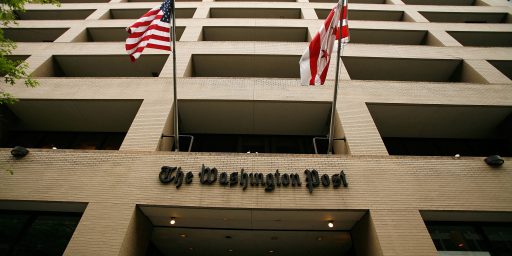How Newspapers Killed Themselves
We all know the Internet broke the monopoly on classified advertising. Here's the rest of the story.

Jack Shafer weighs in against an effort by major newspapers to get an anti-trust exemption that would allow them to band together to force Facebook, Google, and others to pay more for their content. I’m insufficiently informed on the counterargument to have a strong opinion either way. But this bit interested me:
The newspapers that are struggling to compete for digital dollars have partly themselves to blame. In 2000, classified ads made up about 40 percent of newspaper revenue, the Minneapolis Tribune reports. By 2012, that figure had dropped to 18 percent, but Google and Facebook played almost no part in this collapse. Craig Newmark built a better—a much cheaper—classified mousetrap for consumers at Craigslist. eBay also took some of the newspaper market share. But the newspaper industry itself undermined the conventional print classified business as much or more than did Newmark. As I’ve written before, newspaper companies were quick to move classified action to the new, online companies they founded. Gannett, McClatchy, Knight Ridder, Tribune, Times Mirror, Central Newspapers, A.H. Belo, and the Washington Post Co. banded together in 1998 to sell automobiles—long a classified print product—on Cars.com. In 1999, Cox newspapers created Autotrader.com. In 2000, Knight Ridder and Tribune purchased CareerBuilder.com, and two years later Gannett bought in. Apartments.com was yet another co-venture of five newspaper media companies.
—POLITICO, “Newspapers’ Embarrassing Lobbying Campaign“
The role of Craigslist in breaking the newspaper industry’s monopoly on classified ads is well known. Somehow, though, I had no idea that the industry itself was behind cars.com, apartments.com, and even careerbuilder.com. That’s just bizarre.
That these sites and others like them helped destroy their old business model is indeed something of an own-goal. Except for this:
One measure of how lucrative online classified ads became for the newspaper industry could be seen when the Graham family sold the Washington Post to Jeff Bezos for $250 million in 2013. The Grahams retained their share in Cars.com, which they later got $408.5 million for in 2014.
The Grahams’ share of cars.com was worth nearly twice the entirety of the Washington Post! That’s just nuts.






What exactly could newspapers have done to prevent the loss of advertising and the shift from dead tree media to getting news online?
I’m not sure there’s anything.
The economic model for news is changing and it’s clear that, with the possible exception of big-name outlets like The Wall Street Journal, New York Times, and Washington Post, they haven’t figured out how to adjust to the new world.
That is indicative that it wasn’t so much an ‘own goal’ as it was a recognition that the future was coming and if they didn’t grab a piece of it they were going to be left holding the soon to be worth much less 20th century bag.
@Doug Mataconis: @OzarkHillbilly: Agreed. I don’t know what the new model is. It’s incredibly expensive to do original reporting.
I’ll probably tackle the larger issue of the anti-trust exemption at some point. I see some possibility for that to work but don’t think I support the specific plan they’re asking for here.
Here’s an interesting question: Is the purpose of a newspaper to make news stories available to the public (along with all the benefits and implication in investigative journalism, uncovering malfeasance in government and business, etc.), or is it to make money for the owners and shareholders?
Granted, these goals are not mutually exclusive. But which is the dominant goal? The answer is not clear-cut, and to an extent they undercut each other.
A very rich person like Bezos can afford to take a multi-million dollar loss on the Post every year for several decades, and put out a high-quality, useful, honest newspaper every day. But if he did that, he would never be able to sell one share of his paper.
I think you have this exactly backward, as Ozark Hillbilly alludes above. The revenue for the newspaper business came primarily from ads. Put another way, the business was running ads. News was the vehicle. If Allied Van Lines finds a certain size or configuration of truck is no longer in demand, they get a new truck. That’s almost always the correct business decision.
But Craigslist (which, like all user driven internet sensation, has become a cesspool of scams and hooker ads) was only a temporary stop on the Apocalypse Express for the print media. Josh Marshall at TPM has been thinking deeply about this for years and he believes the fundamental problem is that something like, say, the Baltimore Sun had the rug pulled out from it. Previously it had an incredible draw for advertisers. Virtually all their audience was local. Through the use of inserts you could get even more local. Nothing else could cover the local area so specifically and so thoroughly. And then there were specialty news publications that had a specific type of reader like “US News and World Report”. If you wanted to reach the most people who were governmental or international influencers it was hard to beat their audience.
But Facebook and Google changed that equation on both sides. First off, ad buyers could use their tools to get even more hyperlocal and hyperspecific than the newspapers. For example, my MakerSpace targets people who search on certain terms (MakerSpace, DIY, etc) within a 20 mile area and we do so for pennies per hit. A car dealership could ask for nearby people with two or more kids under sixteen who last bought a car 3 years ago and who have used the term “SUV” in a gmail or search. That would cost far more than pennies per view but it may well be worth it.
And here’s the zinger. If the Baltimore Sun partners with Google or Facebook or any other on line ad company, they have no advantage over any other ad displaying website. Google doesn’t need to know that someone is reading the Sun to recognize that they are local. They can serve that ad to you no matter what site you are browsing, because they know who you are and know what site you are at. And if the Sun says, man, we are shooting ourselves in the foot, so we won’t play, it doesn’t matter all that much to Google. People are on dozens of websites a day. If they can’t serve you when you are reading the Sun, they will serve you when you are visiting CatLOLZ.com.
What I’m seeing here is that the newspaper–particularly the large, metropolitan kind–has become the next buggy whip in our cavalcade of creative destruction. If that is the case, then stop worrying and start looking for the new innovation that will replace newspapers. The market will provide. And it will be wonderful because the market never makes mistakes.
test
Dear Wheeler: You provide the prose poems. I’ll provide the war.
Am I the only one noticing that the Graham family understood what business they were in, selling ads and gutted their own newspaper? Same with the others media companies that opened advertising vehicles gutting their old medium, newspapers.
Now, they could have opened the targeted advertising sites and used the revenue to support their “journalism” just like the old classified ad did, but they chose not to do that. Instead the “status” (news reporting) portion of their old business model was set adrift to make its way without the revenue to keep the engines running.
This observation on the rise of magazines in the 1930s (written in 1939) seems to mark the start of this golden period of magazines and newspapers.
@Mister Bluster:
Great movie. I have the DVD with Roger Ebert’s commentary.
Great Movie!*
*spoiler alert